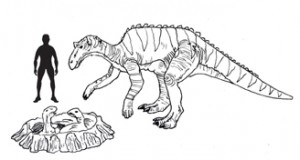Remembering “Good Mother Lizard” and Charles Othniel Marsh (1831 -1899)
Today is “Mother’s Day” a day celebrating mums around the world, otherwise known as “Mothering Sunday” not every country recognises this day as a special day for mums. For example, in Australia, “Mothers Day” is celebrated sometime in May we think, but it gives us an excuse to write about one of our favourite ornithopods – Maiasaura. Today also marks the anniversary of the death of one of the most influential palaeontologists of the 19th century – Charles Othniel Marsh.
Maiasaura
Maiasaura was a large, flat-headed duck-billed dinosaur that lived in North America. It is a member of the Ornithopoda. The first fossils of this dinosaur were discovered in the Badlands of Montana thirty-four years ago by a team of American scientists led by palaeontologist Jack Horner. The site the team uncovered consisted of a number of dinosaur nests, eggs, baby Maiasaura, adults and juveniles. The location was renamed “Egg Mountain” and represents the fossilised remains of a Maiasaura nesting site. More than two-hundred individual specimens have been excavated, providing scientists with evidence of the nesting behaviour of dinosaurs. Maiasaura was formally named and described by Jack Horner and Robert Makela. The name means “Good Mother Lizard” and in contrast with most of the Dinosauria, it takes the female form of the Latin term for lizard – saura.
An Illustration of a Maiasaura and her Nest
Picture credit: Everything Dinosaur
Careful study of the fossils found on “Egg Mountain” led to some intriguing insights into ornithopod nesting behaviour. For example, many of the baby Maiasaura were clearly too large to be newly hatched, but they were evidently still living in the nest. The conclusion made was that these dinosaurs stayed in the nest whilst the parents or a parent looked after them, bringing them food. Some scientists have postulated that Maiasaura were strongly social creatures, living in large herds.
Charles Othniel. Marsh, no doubt would have been fascinated by the fossils of Maisaura. This pioneer of palaeontology passed away on March 18th 1899. This American palaeontologist; who organised and led many expeditions to the newly opened up western United States; named and described at least twenty-five dinosaur genera, famous dinosaurs such as Apatosaurus and Allosaurus as well as a huge number of other prehistoric animals.
Appointed professor of palaeontology at Yale University in 1860, he persuaded his uncle George Peabody to establish the Peabody Museum of Natural History at Yale and he helped build up an extensive fossil collection.
So on Mothers Day we remember “Good Mother Lizard” and one of the founding fathers of the modern science of palaeontology.
For models of Maiasaura and other ornithopods (whilst stocks last): Wild Safari Prehistoric World Figures.






Leave A Comment